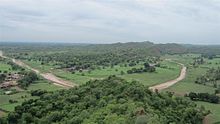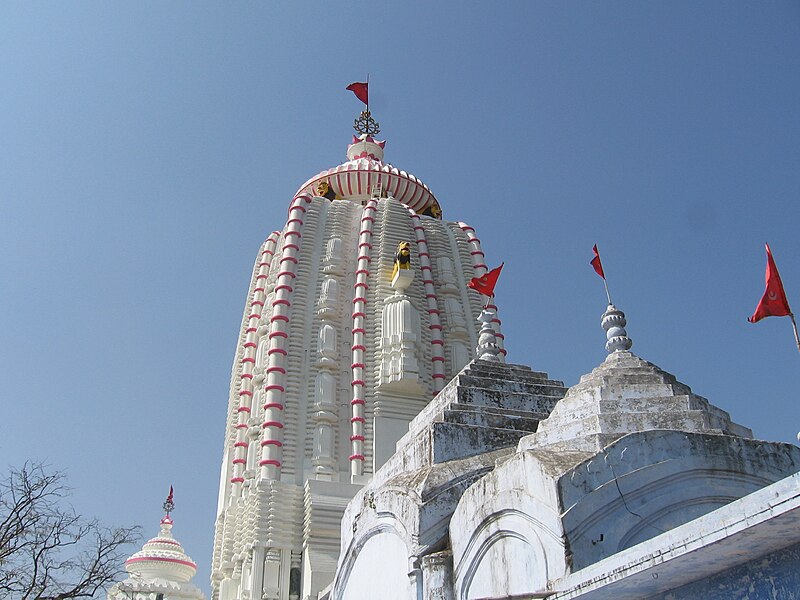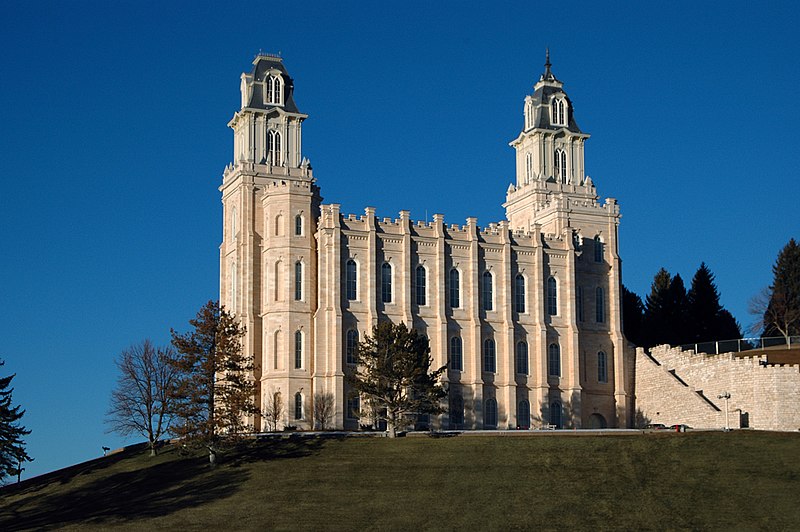Name : Jayanti Devi Temple
Location :
It is believed that the ancient Mata Jayanti Mandir is situated in Kangra district of Himachal Pradesh. Presently, the temple is located 15 km from Chandigarh in Ropar
district of Punjab, on a hillock in the Shivalik ranges. At the foothill
lies the village Jayanti Majri that owes its existence and name to the
temple, on the left bank of a seasonal stream Jayanti River.
Legend :
The name of Jind
town comes from Jayanti, the goddess of victory. The Pandavas built a
temple to Jayanti Devi around which came up the town of Jaintpuri. The
name later morphed into Jind. The story of the temple of Mata Jayanti
Devi is the story of such a precious gift. The story goes back about 550
years, when the Mughals were ruling the country. At that time, a small
estate called Hathnaur was situated at the north of present day
Chandigarh. The king of the estate had 22 brothers. One of the brother
was married to the daughter of the king of Kangra in Himachal Pradesh.
The girl was a great devotee of Mata Jayanti Devi — the mother goddess
of the clan — since her childhood. Every morning she first used to
worship the goddess and only after that she would perform other
activities.
When her marriage was fixed she was very anxious because it meant
going far away from her deity and not being able to have darshan of the
goddess. She prayed hard and conveyed her grief and remorse to the
goddess. Mata Jayanti Devi was moved by the deep devotion of the girl.
She appeared in her dreams and promised to accompany her wherever she
went.
When the marriage party started back from Hathnaur with the bride’s
doli, a miracle happened. Suddenly the doli turned very heavy. Neither
the traditional kahars nor the king’s men could move it. At this, the
bride told her father about her dream. The king, then, bowing to the
desire of the divine arranged for another doli, kept the idol in it and
sent the goddess with his daughter. The pujari and his family followed
the goddess.
The king of Hathnaur, established a temple for the Devi on a hillock
in his estate. First, the girl, and later succeeding generations of the
family, worshipped the deity for 200 years.
At that time, a robber called Garibu or Garibdas extended his
influence on this part of the region, including Mullanpur (now in
Ropar). Gradually, Garibu captured the Hathnaur estate and started his
reign. However, Garibu was a friend of the poor and a great devotee of
Mata. He renovated the temple and extended the premises to the present
state.
Description :
The metalled road leading to the temple is lined with wheat or rice
fields, keekar, peepal and mango groves. As far as the vision goes, one
can see numerous hues of green, the characteristic feature of the
fertile lands of Punjab, small and large ponds with clear water
reflecting the blue sky and tiny hamlets with agriculture-based life
style. The undulating topography and hump-like hillocks give the place a
mysterious character that is absent in the flat planes of Chandigarh.
The entrance to the temple is through a huge gate at the base of the
hillock. From here about 100 or so easy steps lead up to the temple
premises. As one climbs up, the first thing one encounters is a very
large water tank, a traditional feature of Indian temples.
This tank was earlier in use. It is a concrete construction and steps
lead down to it from two sides. The other two sides are bound by the
rocky wall of the hillock. There are a few shops along the steps selling
nicknacks — coconut, red net chunnies, fancy jewellery, cassettes of
devotional songs, toys, photos of the idol etc. The temple is at the
highest point of the hillock supported by massive pillars. This point
gives a wide view of the lush green surroundings, the serpentine Jayanti
Rao and the settlements beyond. Inside the sanctum sanctorum lies the
stone idol of the goddess. In the niches outside there are idols of
Shiva, Ganesha, Laxmi and local deities Lokda Dev and Balasundari in
folk forms.
 |
| Jayanti River visible from temple |
Festivals :
The temple attracts visitors during a grand fair held here on full
moon day in February and a small fair in August. At that time
approximately 1.5 lakh people visit the temple from far and near places.
Devotees also visit it during Navratras, other auspicious days and on
Sundays. Two committees run the management of the temple. One of them
comprises the priest’s family and villagers of Jayanti Majri. It looks
after construction work and expansion projects of the temple. The other
committee consists of residents of Mullanpur. Both the committees hold
langar every Sunday and also during the fair. There is no government-aid
to the temple and the only source of income is contribution by the
devotees. At present, there is a provision of night stay at the premises
for a limited number of devotees. The committee has started work on the
construction of a dharamshala for pilgrims who visit the temple from
far-off places.
The 11th generation of the pujari, who came originally
from Kangra with the idol, now performs the sacred duties of the temple.
The residence of the pujari is also within the premises.
There is only a single bus service from Chandigarh to Jayanti Majri.
That too is erratic. Though the Chandigarh Administration arranges for
buses during the February fair, for the convenience of the village
residents and for visitors, a regular bus service is needed, especially
on Sundays and holidays.
When the new Chandigarh project was conceived, Jayanti Majri was
among the villages to be included in it because it lies at the periphery
of Chandigarh. The Punjab Soil and Water Conservation Department has
constructed a small dam — Jayanti Dam — in this area, that supports a
reservoir for rain water collection. The water is then used for
irrigation of fields. The place can be developed as a beautiful
tourist-cum-religious spot and visitors to Chandigarh can be guided to
visit the temple.
Jayanti Majri is just a 10-minute drive from Chandigarh but it’s an
altogether different world. Silence prevails here. The only sounds that
reach the ears are the rustling of leaves, the humming bees, fluttering
wings of a butterfly and occasional clinking of a temple bell.
As more and more sacred places all over India fall prey to
materialistic ways, it is a relief to find that this temple still
retains a pious aura around it. Consumerism has still not been able to
touch this sacred place with its polluting tentacles.
Jayanti Devi is considered to be a very sensitive and benevolent
goddess who listens to the prayers of her devotees. She is one of the
seven sisters, the seven goddesses of the Kangra valley — Naina Devi,
Jwalaji, Chintpurni, Mansa Devi, Brajeshwari, Chamunda Devi and Jayanti
Devi. As a sign of reverence to Mata Jayanti Devi, the villagers of
Jayanti Majri restrict the construction of their houses to only a single
storey. An ancient well at the base of the temple provides sweet water
throughout the year. Temple has a large complex with park and Jayanti
Archeological Museum.
Websites :
http://en.wikipedia.org/wiki/Jayanti_Devi_Temple



















